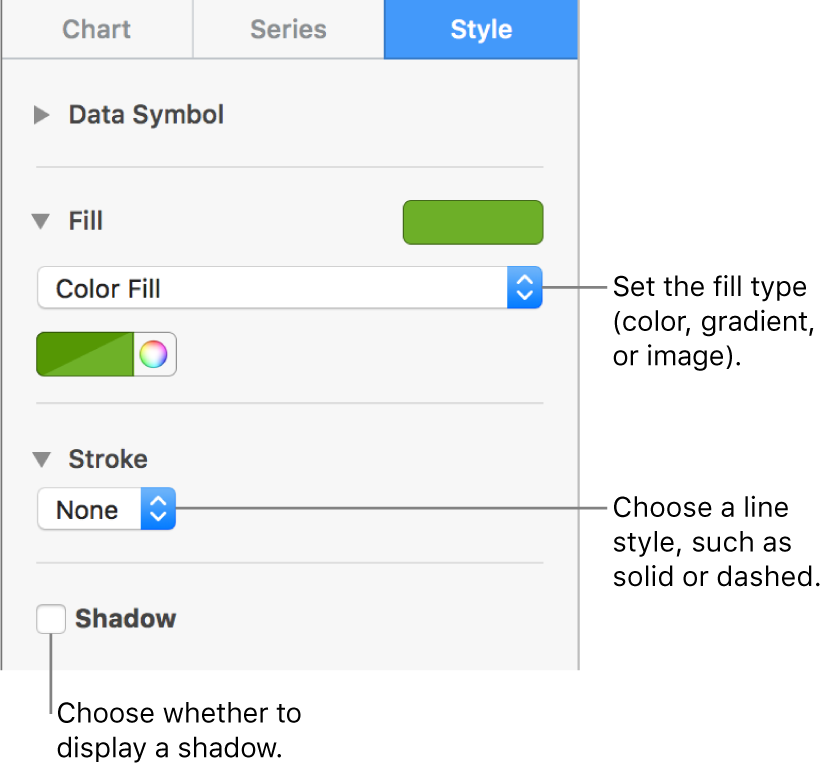
Change the look of bars, wedges, and more in Numbers on Mac
A data series is a set of related values in a chart—for example, all the bars of the same color in a bar chart, or a single line in a line chart.
You can emphasize trends in your chart by changing the appearance, position, or spacing of one or more of the data series.
Change colors and shadows in chart elements
You can change the look of any data series in a chart to differentiate it from other series. For bar charts, for example, you can fill the bars in each series with a different color or a color gradient, apply a different outline (stroke) style, and more. For scatter charts, you can change the symbol that represents each point and add connection lines between the points.
Note: You can’t change the look of a single data point in a series (a single bar in a bar chart, for example). All changes you make apply to every data point in the series.
Click the chart, then click one element of a data series (for example, one bar or column, pie wedge, or scatter point).
The entire data series is selected.
In the Format
 sidebar, click the Style tab.
sidebar, click the Style tab.Use the controls in the sidebar to make changes; to see all options, you may need to click the disclosure triangle next to the name of each section.
The changes affect only the selected data series. To change another series, click one of its elements, then make changes.
To select multiple series, click a series element, then Command-click an element in another series. To select all series, click a series element, then press Command-A.

Tip: You can choose a coordinated set of colors for all the data series in the chart at once. Click the chart, click the Chart tab in the sidebar, then click ![]() and select colors. To preview the colors in your chart, hold the pointer over a color combination.
and select colors. To preview the colors in your chart, hold the pointer over a color combination.
Change the spacing in bar and column charts
You can set the amount of space between the columns or bars in a column, stacked column, bar, or stacked bar chart.
Click the chart, then, in the Format
 sidebar, click the Chart tab.
sidebar, click the Chart tab.Click the disclosure triangle next to Gaps, then set the amount of space.

Add rounded corners to bar, column, mixed, and two-axis charts
Click the chart to select it, then click Chart in the Format
 sidebar.
sidebar.Click the disclosure triangle next to Rounded Corners, then drag the slider or type a specific value.
To round only the two outside corners of each bar or column (those farthest from the axis), select the Outside Corners Only checkbox.
Change the depth of a 3D chart and the shape of series elements
You can change the chart depth, lighting style, bar shape, bevels, and rotation of 3D charts.
Click the 3D chart to select it, then, in the Format
 sidebar, click the Chart tab.
sidebar, click the Chart tab.Click the disclosure triangle next to 3D Scene, then use the controls to make adjustments.
Bevel the edges between series or wedges in 3D stacked and pie charts
Change the position of pie chart wedges and donut chart segments
Select the pie or donut chart.
Do one of the following:
Move only selected wedges or segments: Double-click the wedge or segment, or Command-click multiple items, then drag.
Move all wedges in a pie chart: In the Format
 sidebar, click the Wedges tab. Click the disclosure triangle next to Wedge Position, then drag the Distance from Center slider to separate the wedges.
sidebar, click the Wedges tab. Click the disclosure triangle next to Wedge Position, then drag the Distance from Center slider to separate the wedges.

You can also move the Rotation Angle control to change the orientation of pie wedges or donut segments. You may want to emphasize some data, for example, by positioning certain wedges at the top or bottom of the chart.
Resize the center hole of a donut chart
Click the donut chart to select it.
In the Format
 sidebar, click the Segments tab.
sidebar, click the Segments tab.In the Inner Radius section of the sidebar, drag the slider or type a specific value.
Add or change data symbols in line and scatter charts
You can change the symbols used to represent data in scatter charts.
Click the chart to select it.
In the Format
 sidebar, click the Series tab.
sidebar, click the Series tab.Click the pop-up menu below Data Symbols and choose a symbol, or choose None to remove symbols from the chart.
